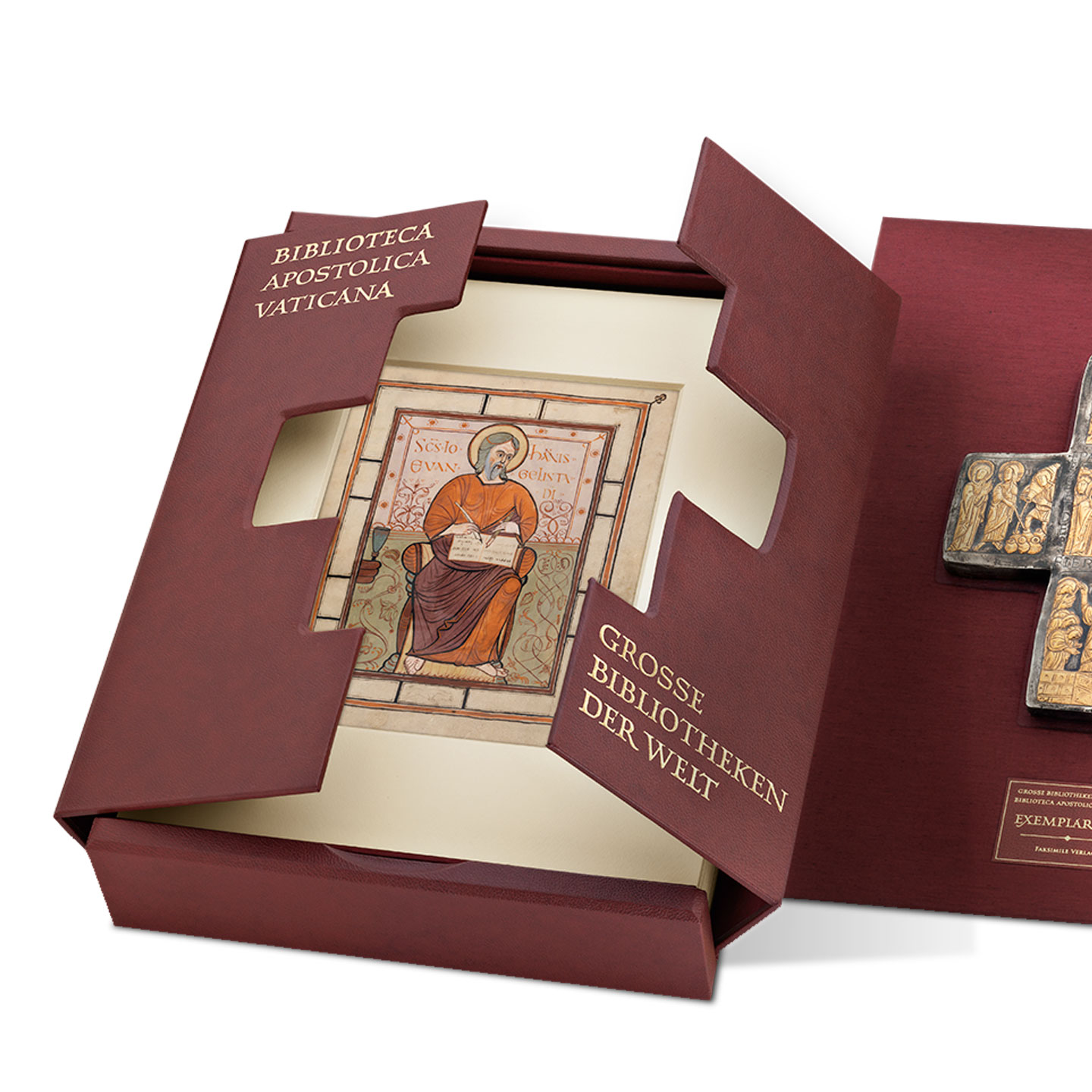Biblioteca Apostolica Vaticana, Vatican City
Treasures of the Biblioteca Apostolica Vaticana – BIBLICA
The facsimile box shows 12 of the most beautiful leaves from the biblical collection at the Vatican Bibliotheca Apostolica, being one of the largest and most important Bible collections in the world.

The motifs:
Epistles of Peter
Papyrus Bodmer VIII, Egypt, 3rd century
Pauline Epistles
Cod. Vaticanus B, Caesarea, 4th century
John the Evangelist
Barberini Gospels, Barb.lat. 570, England, 8th century
Gospel of John (Beginning)
Lorsch Gospels, Pal.lat. 50, Aachen, 9th century
Initial L (Beginning of the Gospel of Matthew)
Gospels, Ottob.lat. 79, Northern France, 9th century
Isaiah’s Prayer
Old Testament/ Book of Kings, Vat.gr. 755, Constantinople, 11th century
King on the Throne
Gospels of Henry II., Ottob.lat. 74, Regensburg, 11th century
The Birth of Christ and Ornamental Page
Gospels of Matthew, Tetra Gospels of John II. and Alexios Komnenos, Urb. gr. 2, Constantinople. 1122-1142
Mark the Evangelist
Tetra Gospels, Vat.copt. 9, Cairo, 13th century
Forty Martyrs
Gospel Reading, Vat.sir. 559, Nineveh, 13th century
Psalms
Old Testament, Ross. 556, Rome, 1293/1294
St. Hieronymus
Bible of Niccolò d’Este, Barb.lat. 613, Ferrara 1430-1434
Treasures from the Biblioteca Apostolica Vaticana – Biblica
9th - 15th Century
The legacy of bibliophile popes
Although even as early as the Middle Ages the papal library was, next to that of the Sorbonne, one of the most important book collections in the world, the actual foundation of the Biblioteca Apostolica Vaticana was a result of Renaissance efforts: Pope Nicholas V (1447–1455) was a significant humanist and collector of books. He established the Vatican Library as an accessible place of scholarship and research for students and academics alike. Today the BAV comprises a huge number of works including around 80 000 manuscripts, 100 000 archived documents, 1.6 million printed books, 150 000 artworks, 150 000 photographs as well as 300 000 coins and medals.
The Acquisitions
Pope Sixtus V (1585–1590) was responsible for housing the library in its current building, which has, over the centuries, become the home of phenomenal new acquisitions of incredible worth. In 1623 Gregory XV (1621–1623) acquired the famous Heidelberg Biblioteca Palatina, ‘the mother of German libraries’. The collections of the dukes from Urbino and Queen Christine of Sweden followed in the second half of the 17th century. The impressive collection of Pope Alexander VIII (Pietro Ottoboni 1689–1691) comprising 3000 manusripts was bought back during the course of the 18th century. This was followed by the Barberini Collection (around 12 000 manuscripts) and the treasures owned by Giovanni Francesco de Rossi.
Biblica
The Vatican is the central pivot of catholic Christianity. It thus does not come as any surprise that a major part of the collection is dedicated to the Holy Scriptures and their heritage. The ‘Bible Facsimile Box’ imparts a representative and broad overview of the unique treasures of the Vatican Library, with twelve leaves spanning nine centuries. The selection ranges from early Christian papyrus (one of the oldest records of the Pauline epistles) to the ostentatious Niccolò d’Este Renaissance Bible and includes biblical manuscripts from Byzantine, Coptic, Arabic and Hebraic cultures.
The Box
The facsimile box ‘The Great Libraries of the World – Biblioteca Apostolica Vaticana’ is limited to 1995 copies worldwide. It comprises 12 duplex leaves mounted in individual passe-partouts. The leaves were produced from the originals in the Vatican Library with the greatest of care. Wherever historically justifiable, the leaves have been enriched by the use of real gold leaf. The box measures approximately 38.0 x 52.0 x 8.7 cm and is bound with the fine burgundy cowhide. It is decorated with a reproduction of the famous Paschalis crucifix dating from the 9th century, which was made exclusively in this size for the Vatican Box. The commentary booklet included in the box was written by Dr. Christine Maria Grafinger, who is the manuscript curator at the Vatican Library and made this achievement possible.



